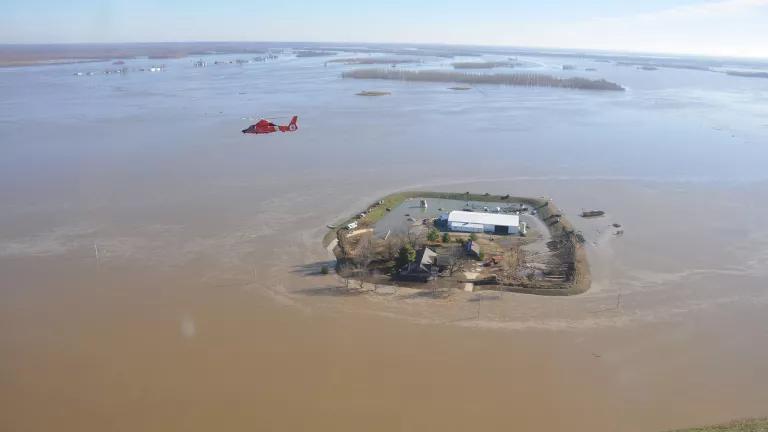
The ground in the Midwest during a typical winter is cold and dry. But with runners jogging in shorts along Lake Michigan just two days before Christmas, this is no typical winter. In fact, this past December was the hottest ever recorded in the Midwest, and the land in the country’s center was warm and wet.
As 2015 (which is expected to be declared the warmest year on record) came to a close, heavy rainfall washed across already saturated ground and went straight into the Mississippi River, which hit its third-highest level by New Year’s Eve. The overflowing river flooded dozens of communities, and the governors of Missouri and Illinois were soon issuing evacuation orders and declaring states of emergency.
Early summer rains also drenched farm fields, and a steamy autumn prolonged the region’s growing season. Frankly, a lot’s been happening in the Midwest, meteorologically speaking. Some meteorologists believe the current El Niño event may be the strongest one yet—thanks in part (but not in whole) to global warming—and suggest that it’s fueling this mild winter. In addition to El Niño, other perfectly normal weather phenomena, like the Arctic Oscillation—a band of cold winds that swirl around and occasionally (but not lately) dip down from the North Pole to freeze our socks off—are asserting their influence, too.
According to Doug Kluck, a climatologist for the National Oceanic and Atmospheric Administration’s Central Region, as many as 20 different factors may affect weather trends across the country at any given time, and he and other scientist are trying to figure out all the hows and whys in order to help Midwesterners prepare for the future.
So far, what Kluck, and Michael Timlin, a climatologist with the Midwestern Regional Climate Center, have been able to parse out are longer-term trends, namely winters with less severe and shorter cold snaps (just like 2015’s). They’re also seeing bigger rain events with longer dry spells in between and have noted that minimum annual temperatures throughout the region have gradually gone up over the past 120 years or so. In the northern tier of the Midwest, like Minnesota, those increases have occurred faster, a change that jibes with what climate models predict will happen as more carbon dioxide is introduced into the atmosphere.
As average temperatures continue to creep higher, which regional climatologists predict they will, water levels in the Great Lakes could rise and fall dramatically as precipitation also becomes erratic. Beginning in 1998, the lakes’ water levels fell for 15 years, with evaporation as the primary reason. Then, in 2013, it rained 10 percent more than average for two years and lake levels shot up again (Lake Superior rose two feet higher, Lake Michigan three).
Changes in precipitation, however, are harder to predict than temperature, say Timlin and Kluck, and that may be because the air over the Midwest is more humid now than it was a few decades ago. One reason may be climate change; another could be that farm fields have more crops than they did 30 years ago. If the uptick in humidity leads to more crop-drowning rain in early summer, as it did in 2015, farmers may have to grow to plants that mature faster, like soybeans, milo, and sorghum, instead of, say, corn. Corn farmers got lucky last year, because the warm fall allowed the stalks to grow well into October.
So 2015 may have been a strange year, but as climate change loads the dice for more extreme weather, wet and warm winters (and scantily clad December joggers) may move from the realm of the unusual to the usual.
This article was originally published on onEarth, which is no longer in publication. onEarth was founded in 1979 as the Amicus Journal, an independent magazine of thought and opinion on the environment. All opinions expressed are those of the authors and do not necessarily reflect the policies or positions of NRDC. This article is available for online republication by news media outlets or nonprofits under these conditions: The writer(s) must be credited with a byline; you must note prominently that the article was originally published by NRDC.org and link to the original; the article cannot be edited (beyond simple things such grammar); you can’t resell the article in any form or grant republishing rights to other outlets; you can’t republish our material wholesale or automatically—you need to select articles individually; you can’t republish the photos or graphics on our site without specific permission; you should drop us a note to let us know when you’ve used one of our articles.

Midwest Heat Waves May Cook Crops—and Fry Harvests
Great Lakes Levels Are Rising—a Sign of Things to Come?
Raising the High-Water Mark